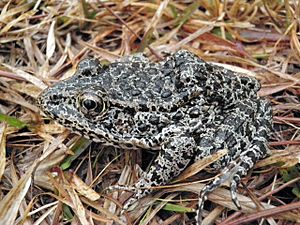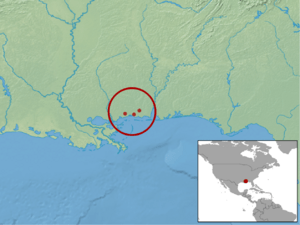Mississippi gopher frog facts for kids
Quick facts for kids Mississippi gopher frog |
|
|---|---|
 |
|
| Conservation status | |
| Scientific classification | |
 |
|
| Synonyms | |
|
The Mississippi gopher frog (Lithobates sevosus) is a special kind of frog. It's also known by names like the dark gopher frog or dusky gopher frog. This frog is part of the true frog family, called Ranidae. It is in big trouble because it is critically endangered, meaning it's very close to disappearing forever.
This frog lives only in the southern United States. Its natural homes are warm coastal forests and temporary freshwater marshes. This shy frog is usually about 3 inches (8 cm) long. It has a dark brown or black back covered in small bumps, like warts.
Contents
- Frog Facts: What is a Mississippi Gopher Frog?
- Where Do These Frogs Live?
- What Does a Gopher Frog Look Like?
- What Do Gopher Frogs Eat?
- How Do Gopher Frogs Protect Themselves?
- Where Do Gopher Frogs Make Their Homes?
- Population and Life Cycle
- Who Are the Gopher Frog's Enemies?
- What Threats Do Gopher Frogs Face?
- How Are People Helping Gopher Frogs?
- Court Case About Frog Habitat
- Images for kids
- See also
Frog Facts: What is a Mississippi Gopher Frog?
The Mississippi gopher frog was first described as a new species in 1940. For a while, people thought it was just a type of the more common gopher frog. But in 2001, scientists decided it was its own unique species again.
Where Do These Frogs Live?
The Mississippi gopher frog used to live in many places. It was common along the Gulf Coastal Plain in Louisiana, Mississippi, and Alabama. But it hasn't been seen in Alabama since 1922 or in Louisiana since 1967.
Today, there are only two known groups of these frogs left. About 100 frogs live in Glen's Pond in Harrison County, Mississippi. Another smaller group lives in the wetlands around Mike's Pond in Jackson County, Mississippi. These two groups are only about 32 km (20 mi) apart.
Sadly, the places where these frogs live are shrinking fast. This is because of cities growing, forests being cut down, and even fire prevention. Fires are actually important for keeping the wetlands sunny, which helps the frogs' habitat grow.
What Does a Gopher Frog Look Like?
The Mississippi gopher frog is a medium-sized, strong frog. It grows to be about 3 inches (8 cm) long. Its back can be black, brown, or gray. It has dark spots and bumps all over its back.
Male gopher frogs make a sound that some people compare to human snoring. This shy frog has a unique defense. If it sees a bright light or feels threatened, it will put its hands over its eyes. It might also puff up its body to look bigger. Another defense is releasing a bitter, milky liquid from glands on its back. These frogs can live for six to 10 years.
What Do Gopher Frogs Eat?
Adult Mississippi gopher frogs likely eat other frogs and toads. They also enjoy insects, spiders, and earthworms.
How Do Gopher Frogs Protect Themselves?
The Mississippi gopher frog has special ways to fight off sickness. Its body is good at finding and stopping tiny invaders like bacteria. It reacts quickly to these threats, helping to stop infections early.
Like other frogs, it makes special chemicals called antimicrobial peptides. These chemicals are released from glands in its skin. They are very good at killing certain harmful germs in just a few minutes. These chemicals are released when the frog is stressed or injured. They only attack the outside of the harmful germs, not the frog's own body.
Where Do Gopher Frogs Make Their Homes?
The Mississippi gopher frog lives in two main types of places. It needs sandy areas with open longleaf pine forests and lots of plants on the ground. It also needs small, temporary wetland ponds for breeding.
Adult frogs spend most of their lives underground. They hide in old burrows made by gopher tortoises or other animals. They also use holes in tree stumps and roots, and sometimes even crayfish burrows.
The ponds they use for breeding are special. They are usually grassy and dry out completely at certain times of the year. This is important because it stops fish from living there. Fish would eat the frog tadpoles, so no fish means safer tadpoles! For the frogs to reproduce successfully, there needs to be a lot of rain in winter. This fills the ponds enough for the young frogs to grow. Adult frogs move to these ponds during heavy rains from December to April. The tadpoles must grow into young frogs before the ponds dry up in early summer.
Population and Life Cycle
The Mississippi gopher frog was listed as endangered in Mississippi in 1992. The US Fish and Wildlife Service listed it as endangered in 2001. The main group of these frogs left has only about 100 adults. This makes the Mississippi gopher frog the rarest amphibian in North America.
Scientists found a group of these frogs at Mike's Pond in 2004. But now, the only place you can reliably find them is at Glen's Pond in Harrison County, Mississippi.
The number of these frogs changes a lot. This is because adult frogs sometimes die, and not enough adults return to mate. The population relies on young frogs returning to reproduce. Male frogs become ready to mate at about 6–8 months old. Females take longer, at two to three years old. While many frogs survive to adulthood, only a small number return to mate. Adult frogs live to about 7 years old. They are estimated to reproduce only once every 4–5 years.
Female frogs lay egg masses that are about the size of a fist. Each mass can have 2,000 or more eggs. These eggs are usually attached to plant stems in the water. Tadpoles are a little over 1 inch (3 cm) long. It takes them 80 to 180 days to change into young frogs.
Who Are the Gopher Frog's Enemies?
Adult frogs face dangers from birds, mammals, and reptiles. Tadpoles can be eaten by fish, water insects, birds, turtles, and snakes.
A disease called chytridiomycosis, caused by a fungus, has also hurt Mississippi gopher frog populations.
What Threats Do Gopher Frogs Face?
The number of Mississippi gopher frogs has dropped because they have lost their homes. They need open longleaf pine forests and seasonal ponds. In the 1930s, people started stopping forest fires. But fires are actually important for keeping the forests open and healthy for the frogs. Fewer gopher tortoises also hurt the frogs. Gopher tortoises dig burrows that the frogs use for shelter.
Other natural problems also threaten the frogs. These include being too isolated, inbreeding (when closely related frogs mate), droughts, and floods. Inbreeding means the frogs have less variety in their genes, which makes them weaker and less able to survive.
People also cause problems for the last remaining breeding pond. There are plans for new homes, highways, and train lines. These projects can change water flow, require stopping fires, and destroy the frog's habitat. Chemicals from runoff could also harm or kill tadpoles and adult frogs.
Another big threat is that the frogs are so spread out. If they are not close together, they can't reproduce. This makes the population smaller. If they do reproduce, it might be with close relatives, which lowers their genetic variety. This makes it harder for them to survive.
The survival rate for gopher frog eggs is very low, between 0-5.4%. Some insects, like caddisfly larvae, can eat the eggs.
How Are People Helping Gopher Frogs?
Because the Mississippi gopher frog is so endangered, there's a big effort to save it. A special team is working to help the frogs. They manage the frog's habitat and make sure there's enough water in the ponds. They also raise tadpoles in safe places to release them later. They are building new breeding ponds and trying to control diseases. Introducing more gopher tortoises is another idea to give the frogs more places to live.
The US Fish and Wildlife Service and the US Forest Service are working together. They are trying to protect the last frogs and create new breeding sites. They are putting frog eggs into new ponds to see if they can grow there. They also use controlled fires to keep the forests healthy, which helps both the frogs and gopher tortoises.
Five zoos are also helping. The zoos in New Orleans, Memphis, Detroit, Miami, and Omaha have about 75 Mississippi gopher frogs. They are trying to breed them in captivity to help increase their numbers.
Court Case About Frog Habitat
In 2018, the United States Supreme Court heard a case about the gopher frog. Landowners challenged a decision to make 1,500 acres of forest in Louisiana a "critical habitat" for the frog. This means it's a very important area for the frog's survival.
The Supreme Court sent the case back to a lower court to be looked at again. They didn't decide if the area should be a critical habitat or not. They wanted the lower court to check if the government's decision was fair.
Images for kids
See also
 In Spanish: Lithobates sevosus para niños
In Spanish: Lithobates sevosus para niños




